Artsakh Defence Army
The Artsakh Defence Army (Armenian: Արցախի Հանրապետության պաշտպանության բանակ, romanized: Artsakhi Hanrapetut’yan pashtpanut’yan banak) is the formal defence force of the unrecognized Republic of Artsakh (Nagorno-Karabakh). Established in 1992, it united previously disorganized self-defence units which were formed in the early 1990s with the avowed goal of protecting the ethnic Armenian population of Artsakh from attacks by Soviet and Azerbaijani armed forces.[2] The Artsakh Defence Army is currently composed of around 20,000 officers and soldiers and maintains a "constant state of readiness, undergoing more serious combat training and operational exercises than any other former Soviet army.".[3]
| Artsakh Defence Army | |
|---|---|
| Արցախի Հանրապետության պաշտպանության բանակ | |
 Patch | |
| Founded | 9 May 1992 |
| Service branches | Ground Forces Air and Air Defence Force |
| Headquarters | Stepanakert |
| Leadership | |
| Commander-in-Chief | Arayik Harutyunyan |
| Minister of Defence and Defence Forces Commander | Lieutenant General Mikael Arzumanyan |
| Chief of Staff | Kamo Vardanyan |
| Manpower | |
| Military age | 18 |
| Conscription | 24 months |
| Active personnel | 18,500–25,000 |
| Reserve personnel | 20,000–30,000[1] |
| Related articles | |
| History |
|
History
Establishment
The Artsakh Defence Army was founded on 9 May 1992. It created "its own central command and military structure distinct from the Armenian Army."[4] Its founders included Robert Kocharyan (the former President of Armenia, he was the first commander-in-chief of the Army);[5] Serzh Sargsyan (former Prime Minister and President of Armenia); Vazgen Sargsyan (Armenia's Defence Minister 1992–93, State Minister in Charge of defence 1993–95, Armenia's Prime Minister 1998–99);[5] Monte Melkonian (responsible for Martuni Province);[6] Samvel Babayan (Nagorno-Karabakh's Defence Minister from 1994 to 2000) and others.[5] Many of the men who served in its ranks and in the officer corps during the First Nagorno-Karabakh War were seasoned veterans of the Soviet military and had fought in the Soviet–Afghan War.[3]
First Nagorno-Karabakh War
The formal formation of the NKR Defence Army was rooted in the concept of the Jokat (volunteer detachment).[6] With the early outbreak of hostilities prior to 1992, Armenians of Nagorno-Karabakh began forming small detachments of volunteers, often self-described as Fedayeen, inheriting the name of the fighters who actively resisted the Ottoman Empire in the final decades of the nineteenth and early decades of the twentieth centuries.
At the outset these detachments were small groups of no more than 12–40 men. For example, during Operation Ring, Shahumyan was defended by a force as small as 22 men under the command of Tatul Krpeyan. These volunteer militia would initially arm themselves with whatever was available, including hunting shotguns borrowed from local farmers and even home-made rifles. In the later stages of the war, these units armed themselves with AK-47s, RPGs and sometimes portable anti-aircraft MANPADs, transforming the defence force into a highly mobile and flexible force that was capable of waging guerrilla warfare. Likewise, these units initially had no heavy military equipment, but later started taking over large quantities of Azerbaijani tanks and armoured personnel carriers that were abandoned on the battlefield. Most of these captured tanks and APCs later became part of the NKR Defence Army's equipment. Improvization, multi-functionality, creativity, strong-morale, focus on defensive tactics, adaptation, flexibility, high-mobility and a native knowledge of the mountainous terrain are all important factors in understanding the combat success of these small units.
The initial purpose of these detachments, made up of volunteers, was mainly to defend Armenian civilian population, each in a particular village or town. Each of them was operating independently with no central command or leadership. Yet, these units would regularly collaborate in joint operations such as the battle of Khojaly in February 1992 or the June 1992 surprise counter-offensives during Operation Goranboy. The increasing scale and intensity of Azerbaijani attacks, the devastation caused by Grad multiple rocket launchers firing from Shusha and the Lachin, the blockade from mainland Armenia had broadened the notion of security beyond the mere defence of a small village. Capturing Shusha and Lachin as well as turning the tide of Operation Goranboy became, for the Armenians, not only a matter of security, but that of survival.[7] For the successful conduct of such large-scale operations, the detachments had to be consolidated under a single, unified command.
Mient Jan Faber argues that "August 1992 marked the watershed between purely voluntary Armenian Karabakh forces reinforced by volunteers from Armenia and an organised NKR army with its own central command and a military structure distinct from the Armenian army."[8]
Post war
The Nagorno-Karabakh Defence Army's primary role after the conclusion of the First Nagorno-Karabakh War in 1994 is the protection of the NKR from foreign and domestic threats. Though the war ended with the signing of a cease fire between Armenia, Nagorno-Karabakh and Azerbaijan and the de facto independence of the NKR, the Azerbaijani leadership has repeatedly threatened to restart hostilities to retake the region.[9] Violations of the cease fire along the line of contact are frequent and often result in the deaths of several soldiers and civilians each year. One of the most significant breaches of the ceasefire occurred in Martakert on 8 March 2008, when up to sixteen soldiers were killed. Both sides accused the other of starting the battle.[10] In June 2010, new skirmishes broke out between Armenian and Azerbaijani troops along the line of contact, resulting in the deaths of four Armenian servicemen.[11] Clashes in summer 2014 resulted in the deaths of six Armenian and thirteen Azerbaijani servicemen. On 12 November 2014, a Nagorno-Karabakh Defence Army Mi-24 attack helicopter participating in the week-long joint Armenian–NKR Unity 2014 military exercises was shot down by the Azerbaijani military, killing all three crew members. On 1 April 2016 war-like clashes began; according to several sources they were the worst since 1994. The Artsakh Defence Army suffered a defeat in the 2020 Nagorno-Karabakh war, fighting against the military of Azerbaijan.
Structure
Units
Yeghnikner Detachment
The Yeghnikner ("The Deers") Detachment was founded on 11 March 1993. It originated from a partisan unit created by Shahen Meghryan, which was formed on 25 June 1992 from self-defense detachments of the district villages. Among its symbols were the coat of arms of the Meliks of Gulistan and its unit banner. The Shahumyan Defensive Region (SDR) was formed by the Chairman of the Self Defense Committee in March 1993, originally incorporating two battalions Between 1993 an 1994, SDR units participated in battles and operations in Martakert and Shahumyan.[12][13]
Shushi Independent Battalion
The Shushi Independent Battalion was formed on 1 September 1992, originally consisting of over 1,000 soldiers including many from the United States, Canada, Syria, France, Iran, Russia and Georgia.[14] A memorial to the fallen military personnel from the battalion was erected on the southern top of Mount Aragats in 2003. Most soldiers in the battalion were members of the ARF.
Special Forces
The Special Forces of the Artsakh Defense Army was established in 2000. Based on the previous National Guard, it carrys out both of planned and unplanned combat operations. Among its notable commanders were Samvel Harutyunyan. On 11 August 2010, a memorial fountain was unveiled in Aygestan community of Askeran region on August 10 in memory of the fallen soldiers of the Special Forces. The memorial was built with the financial means of the former and current servicemen of the detachment.[15]
Military education
- Kristapor Ivanyan Military College
- Vazgen Sargsyan Military University
- Marshal Baghramyan Aviation Academy
- Armenak Khanperyants Military Aviation University
Equipment
The Nagorno-Karabakh Defence Army's equipment consists of infantry, tanks, artillery and anti-aircraft systems. The Karabakh army's heavy military hardware includes: 186[16][17] tanks, 68[16][17] armoured vehicles, 98[16][17] artillery pieces of calibres over 122mm, 44 multiple rocket launchers[16] (most likely BM-21 Grad), and a anti-aircraft defence system of an unspecified type[16] WM-80, Scud-B: at least 4 launchers.
As for infantry, most rely on the AK-74 rifle and older AKMs in reserve for standard-issue rifles. Other basic weapons consist of Makarov PM pistols, PK machine guns, and RPG-7 rocket launchers, all mostly supplied by Armenia. The Nagorno-Karabakh military is deeply integrated with the Armenian military, and the NKR depends on the Armenian Army to ensure its survival as an independent national entity. Armenia considers any act of aggression against Karabakh as an act of aggression against itself.[3]
Small arms
| Name | Origin | Type | Image | Notes |
|---|---|---|---|---|
| Pistols | ||||
| Makarov | 9x18 mm |  |
||
| Assault rifles | ||||
| AKM | 7.62x39mm | |||
| AK-74 | 5.45×39mm | 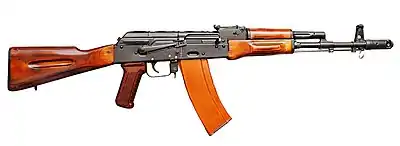 |
Standard rifle of Artsakh Defence Army. | |
| AK-74M | 5.45×39mm | |||
| AKS-74U | 5.45×39mm |  |
||
| Sniper rifles | ||||
| Dragunov SVD | 7.62×54 mm |  |
||
| Zastava M93 Black Arrow[18] | 12.7×108 mm |  |
||
| Machine guns | ||||
| RPK-74 | 5.45x39mm | 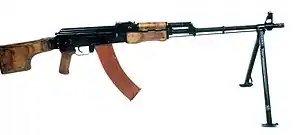 |
||
| PK machine gun | 7.62×54 mm | 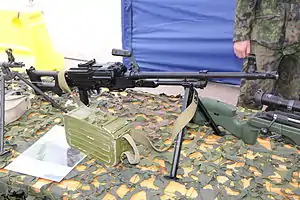 |
||
| DSHK | 12.7×108 mm | 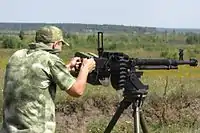 |
||
| NSV machine gun | 12.7×108 mm | 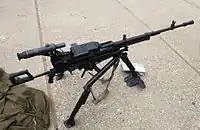 |
||
Vehicles
| Name | Origin | Type | Number | Image | Notes |
|---|---|---|---|---|---|
| Infantry fighting vehicles | |||||
| BMP-1 | Infantry fighting vehicle | 13 |  |
Six 9M14M "Malyutka" ATGMs were fitted on an elevatable mount from the 9P122 tank destroyer on the top of the turret at the rear.[19] | |
| BMP-2 | Infantry fighting vehicle | 7 | 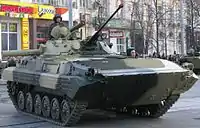 |
BMP-2s variant in use. | |
| Main battle tanks | |||||
| T-72 | Main battle tank | 187[17] | 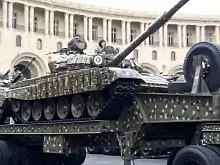 |
NKR T-72, T-72A, T-72AV and T-72B variants in use. | |
| Multiple rocket launchers | |||||
| BM-21 Grad | Multiple rocket launcher | N/A |  |
||
| Scud-B | Multiple rocket launcher | 4 | |||
| WM-80 | Multiple rocket launcher | N/A | 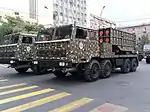 |
273mm MRLS | |
Air Force
The Nagorno-Karabakh Defence Army maintains a small air force with a personnel of around 250 men.[1]
| Aircraft | Origin | Type | Number | Image | Notes |
|---|---|---|---|---|---|
| Ground attack aircraft | |||||
| Sukhoi Su-25 | Close air support aircraft | 2[1] | .jpg.webp) |
||
| Attack helicopter | |||||
| Mil Mi-24 | Attack helicopter | 4 | .jpg.webp) |
During the military parades on 9 May 2007 and 2012, 5 Mi-24 helicopters were on display as part of Nagorno-Karabakh's Air Force. One Mi-24 belonging to the Nagorno-Karabakh Defence Army was shot down by the Azerbaijani military on 12 November 2014. | |
| Transport and utility helicopters | |||||
| Mil Mi-8 | Medium transport helicopter | 5 | .jpg.webp) |
Advanced Research and Assessment Group of the Defence Academy of the United Kingdom reports that NKR Army has 5 other helicopters.[1] These are most likely transport and utility helicopters. Indeed, in 2012 parade, 5 Mi-8 helicopters were on display. | |
| Unmanned aircraft | |||||
| Krunk UAV | UAV | 4 | 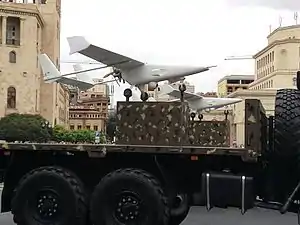 |
At least 2 new upgraded types of Krunk UAV shown on 2012 military parade in Stepanakert. | |
Main battles it has participated in
- Capture of Shusha on (8–9 May 1992)
- Opening the Lachin corridor between Armenia and Nagorno-Karabakh (1992)
- Mardakert and Martuni Offensives (summer–autumn 1992)
- Defence of the Martakert front from 1992–1994
- Battle of Kalbajar on (27 March – 3 April 1993)
- Agdam, Fizuli, Jebrail and Zangelan offensives (June–August 1993)
- 2008 Mardakert clashes
- 2010 Mardakert clashes
- 2016 Nagorno-Karabakh clashes
- Battle of Hadrut (October 2020)
- Battle of Shusha on (4–7 November 2020)
Military culture
Music
Traditional music in the Defence Army includes a large repertoire of Armenian and foreign music, which also includes traditional Georgian and Russian marching music.[20] Russian marches include Den Pobedy, the March of the Preobrazhensky Regiment, and the Jubilee Slow March "25 Years of the Red Army". The band maintains a military band that was notably led by Nerik Grigoryan and Vagan Sargsyan[21] and participates in holidays such as the Day of the Artsakh Republic.[22] It is associated with the Band of the General Staff of the Armed Forces of Armenia. The army also maintains the Song and Dance Ensemble "Aspet".
Liberation Day and Homeland Defenders Day
Shusha Liberation Day (9 May) and Homeland Defender's Day (28 January) are two military holidays celebrated by the Defence Army. The former commemorates the founding of the military as well as the Capture of Shusha and the traditional Victory Day celebrations commemorating the surrender of Nazi Germany at the end of the Great Patriotic War in 1945. Because of this, it is sometimes referred to as a "triple holiday". An annual military parade[23] is held in the capital, with a reception being held at the local House of Officers in the capital.
Whereas the Armenian Army celebrates Army Day on 28 January, the Defence Army celebrates Homeland Defender's Day on the same day.[24]
See also
References
- Blandy, C. W. "Azerbaijan: Is War Over Nagornyy Karabakh a Realistic Option? Archived 2016-04-15 at the Wayback Machine" Advanced Research and Assessment Group. Defence Academy of the United Kingdom, Caucasus Series 08/17, 2008, p.16.
- Important Facts about the NKR Defence Army (Nagorno Karabakh Army). Office of the Nagorno-Karabakh Republic, Washington D.C. Accessed 27 November 2009.
- Giragosian, Richard. "Armenia and Karabakh: One Nation, Two States." AGBU Magazine 19/1 (May 2009), pp. 12–13.
- Dzelilovic, Vesna Bojicic. "From Humanitarianism to Reconstruction: Towards an Alternative Approach to Economic and Social Recovery from War" in Global Insecurity (Restructuring the Global Military Sector), Vol. 3, eds. Mary Kaldor and Basker Vashee. London: Pinter, 2000, p. 79.
- De Waal, Thomas (2003). Black Garden: Armenia and Azerbaijan Through Peace and War. New York: New York University Press. pp. 196–97, 210. ISBN 0-8147-1945-7.
- Melkonian, Markar (2005). My Brother's Road, An American's Fateful Journey to Armenia. New York: I. B. Tauris. pp. 184ff. ISBN 1-85043-635-5.
- See Melkonian. My Brother's Road, p. 225.
- Mient Jan Faber in Mary Kaldor, Global Insecurity: Restructuring the Global Military Sector, volume III UNU/WIDER, London and New York: Pinter, 2000, p. 79. ISBN 9781855676442.
- "Azeri Assault on Karabakh Outpost Kills Four Armenian Soldiers." Asbarez. 21 June 2010. Retrieved 22 June 2010.
- Yevgrashina, Lada and Hasmik Mkrtchyan. "Azeris, Armenians spar after major Karabakh clash". Reuters. 5 March 2008. Retrieved 10 March 2008.
- "OSCE, EU Condemn Karabakh 'Armed Incident'." RFE/RL. 22 June 2010. Retrieved 22 June 2010.
- "ԲԱՑԱՌԻԿ ՖՈՏՈՌԵՊՈՐՏԱԺ, ՏԵՍԱՆՅՈՒԹ՝ Արցախի Հանրապետության "Եղնիկներ" զորամասից. լեգենդար զորամասում ներկա և ապագա լեգենդները նշեցին զորամասի կազմավորման 25-ամյակը". Լուրեր Հայաստանից | Shamshyan.com (in Armenian). Retrieved 29 July 2020.
- "Documentary About The "Yeghnikner" Detachment – "Dark Forest In The Mountains" | Art-A-Tsolum". Retrieved 29 July 2020.
- "Շուշիի առանձնակի գումարտակ". Radio YAN - Armenian Radio Station. 29 December 2011. Retrieved 29 July 2020.
- https://armenpress.am/arm/news/615616
- DeRouen, Karl and Uk Heo (eds.) Civil Wars of the World: Major Conflicts since World War II. Santa Barbara, California: ABC-CLIO, 2007, p. 151.
- Hans-Joachim Schmidt, "Military Confidence Building and Arms Control in Unresolved Territorial Conflicts," PRIF Reports No 89, Frankfurt am Main, 2009, p.12.
- "Հետք". www.facebook.com. Retrieved 9 October 2020.
- "info sheet armenian BMP1" (PDF).
- "ՀՀ պաշտպանության նախարարության նվագախումբը վրացական երաժշտություն է հնցեչրել' ի պատիվ Ալասանիայի | ԱՐՄԵՆՊՐԵՍ Հայկական լրատվական գործակալություն". armenpress.am. Retrieved 26 September 2018.
- https://nashasreda.ru/pesni-na-russkom-yazyke-zvuchali-v-ispolnenii-voennosluzhashhix-armii-oborony-nkr/
- http://russia-armenia.info/node/31149
- Պաշտպանության բանակի զորահանդեսները
- https://novostink.net/en/1048-president-of-artsakh-addresses-congratulatory-message-on-army-day.html
External links
- Important Facts about the NKR Defence Army (Nagorno Karabakh Army). Office of the Nagorno-Karabakh Republic, Washington D.C.
- Official website of NKR Ministry of Defence
- Official YouTube Channel of the NKR Defence Army
